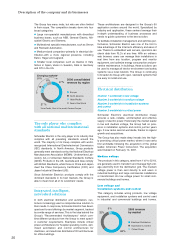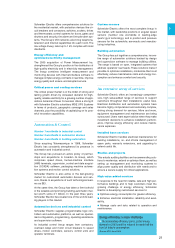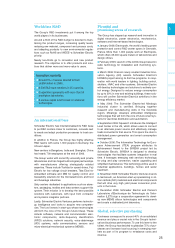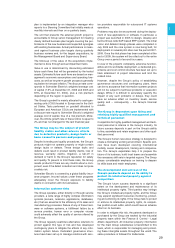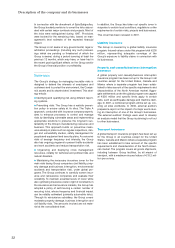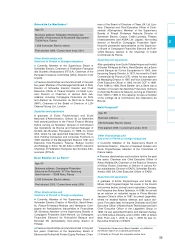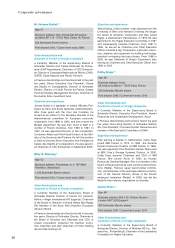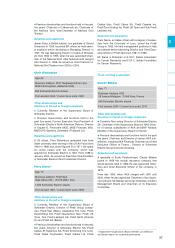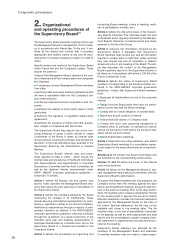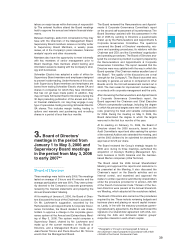APC 2006 Annual Report Download - page 32
Download and view the complete annual report
Please find page 32 of the 2006 APC annual report below. You can navigate through the pages in the report by either clicking on the pages listed below, or by using the keyword search tool below to find specific information within the annual report.
Since 2005, the Group has decided to combat viola-
tions of industrial property rights more vigorously, tak-
ing legal action against patent counterfeiters in Ger-
many, Italy, France and other jurisdictions.
The Group’s plants and products are
subject to environmental regulations
The Group’s plants and products are subject to exten-
sive and increasingly stringent environmental laws and
regulations in all of its host countries.
In order to limit risks related to the environment gener-
ally, the Group is involved in a process to continuously
improve the environmental performance of its plants
and products. In 1992, the Group published a formal
environmental policy, which was recently redefined to
take account of changes both inside and outside
Schneider Electric.
The policy is designed to improve manufacturing
processes, promote eco-design and integrate cus-
tomer concerns in the area of environmental protec-
tion. It also aims to identify, assess and prevent envi-
ronmental risks, in order to guarantee full compliance
with all environmental laws and regulations applicable
to the Group’s businesses. Environmental provisions
are booked when the risks can be reliably measured or
it is probable that clean-up work will be performed and
the related cost can reasonably be estimated. No esti-
mate is made of the potential cost of unidentified envi-
ronmental risks. The Group expects spending on envi-
ronmental compliance programs to increase as a
result of changes to existing environmental regulations
and the introduction of new regulations.
There can be no guarantee that the Group will not be
required to pay significant fines or compensation as a
result of past, current or future breaches of environ-
mental laws and regulations by companies that are
currently or were previously members of the Group.
This exposure exists even if the Group is not responsi-
ble for the breaches, in cases where they were com-
mitted in the past by companies or businesses that
were not part of the Group at the time.
The Group may be exposed to the risk of claims for
breaches of environmental laws and regulations. Such
claims could adversely affect the Group’s financial
position and reputation, despite the efforts and invest-
ments made to comply at all times with all applicable
environmental laws and regulations.
If the Group fails to conduct its businesses in full com-
pliance with the applicable environmental laws and
regulations, the judicial or regulatory authorities could
require the Group to conduct investigations and/or
implement costly clean-up measures to deal with the
current or past contamination of current or former facil-
ities or off-site waste disposal facilities, and to scale-
back or temporarily or permanently close facilities in
accordance with the applicable environmental laws
and regulations.
The Group’s international operations
expose it to the risk of fluctuations in
foreign exchange rates
Because a significant proportion of transactions are
denominated in currencies other than the euro, the
Group is exposed to risk arising from changes in
exchange rates. If the Group is not able to hedge them,
fluctuations in exchange rates between the euro and
these currencies can have a significant impact on its
results of operations and distort year-on-year perform-
ance comparisons.
The Group actively manages its exposure to currency
risk to reduce the sensitivity of earnings to changes in
exchange rates. Hedging programs mainly concern
foreign currency receivables, payables and operating
cash flows, which are generally hedged by means of
forward sales. Depending on market conditions, risks
in the main currencies may be hedged based on recur-
ring forecast flows using contracts that expire in 12
months or less.
The Group’s currency hedging policy is to protect sub-
sidiaries against risks on all transactions denominated
in a currency other than their functional currency. More
than twenty currencies are involved, with the US dollar,
Hong Kong dollar and British pound representing the
most significant sources of risk.
The financial instruments to hedge the exposure of the
Group to fluctuations in exchange rates are described
in notes 20.4 and 20.6 to the consolidated financial
statements for fiscal year 2006 pages 129 and 130
below.
In 2006, the revenue produced in foreign currencies
came to 8,979 million. Foreign currency assets and
liabilities represented respectively 1,973 million and
5,156 million. The main exposure of the Group in
terms of currency exchange risks is related to the US
dollar and to currencies influenced by the US dollar.
The Group estimates that in the current structure of its
operations, a 10% increase of the euro compared to
the US dollar would have an impact of 0.3 points on
operating margin.
Interest rate risk
The Group is exposed to risks associated with the
effect of changing interest rates. Interest rate risk on
borrowings is managed at Group level, based on con-
solidated debt and according to market conditions.The
main goal of interest rate management policies is to
optimize Group financing costs. Most bond debt is
fixed rate.
Less than one year and/or with a variable rate, the
Group has a net cash available of about 1.7 billion.
Up to 1 to More than
1 year 5 years 5 years
Financial liabilities 884.6 2,312.7 1,144.4
Financial assets 2,544.1 315.7
Net position before
management -1,659.5 1,997 1,144.4
A 1% change in interest rates would have an impact of
around 15% on the Group’s financial expense.
The financial instruments to hedge the exposure of the
Group to fluctuations in interest rates are described in
notes 20.4 and 20.7 to the consolidated financial
statements for fiscal year 2006 pages 129 and 130
below.
Counterparty risk
Transactions involving foreign currency and long and
short-term interest rate hedging instruments are
entered into with selected counterparties. Banking
counterparties are chosen according to the customary
Description of the company and its businesses
30


